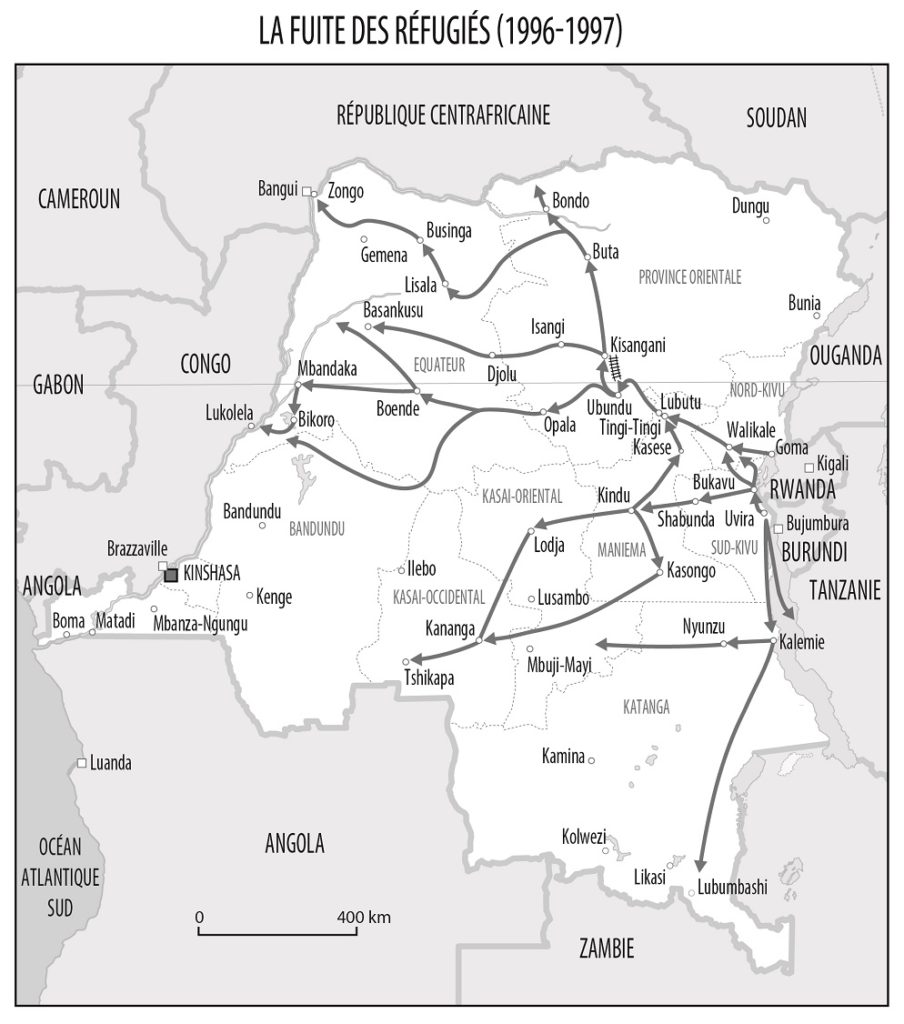From October 1990, the Rwandan Patriotic Front (RPF) waged war against the then Rwandan government. From the North of the country southward, civilians fled RPF mass atrocities it carried throughout its seized areas “both during the course of combat […] and in the more lengthy process of establishing its control throughout the country” ( Des Forges, A. L., 1999, p. 789).
After RPF victory in July 1994, two million Rwandans, including armed elements of former government soldiers fled to surrounding countries and the estimated 1.1 million ended up in Zaire, now Democratic Republic of the Congo (DRC).
This population settled in camps, the great majority in Eastern part of Zaire and the next largest number in Tanzania, where they were nourished at the expense of the international community and Humanitarian organizations like Médecins Sans Frontières and the United Nations High Commissioner for Refugees (UNHCR).
By mid-October 1996, refugee camps in Eastern DRC were home to 527,000 and 718,000 Rwandan Hutu refugees in South-Kivu and North-Kivu respectively. The new Rwandan government repeatedly demanded international intervention to separate the refugees, many of them women and children, from the armed elements, former soldiers (ex-FAR) and militia members.
October 1996 to May 1997, Tutsi troops of the Rwanda-backed Alliance des Forces Démocratiques pour la Libération du Congo-Zaïre (AFDL) waged war in the country. Elements of the AFDL and, more so, of the Rwandan Patriotic Army (RPA) systematically shelled numerous camps and committed massacres with light weapons. These early attacks cost the lives of an estimated 6,800-8,000 refugees and forced the repatriation of 500,000 – 700,000 refugees back to Rwanda. (Ezimet, 2000).
In Rwanda: Refugees who were returned to Rwanda faced killings in their villages, sharing similar fate with those who remained in the country since October 1990 where “large-scale indiscriminate killings of men, women, children, including the sick and elderly, were consistently reported”, for example in “significant areas of Butare Prefecture, Kibungo Prefecture, and the southern and eastern areas of Kigali Prefecture have been […] the scene of systematic and sustained killing and persecution of the civilian Hutu populations by the [Rwandan Patriotic Army]. These activities are reported to have begun, […] immediately following the expulsion from each area of former Government military, militia and surrogate forces” (Gersony, 1994).
On the hills of Rwanda, the RPF massacred Hutus in batches of tens, hundreds and sometimes thousands, “injecting syringes of kerosene into ears. Smothering people with plastic bags. Choking with ropes and cords. Impaling women and girls with tools. Using agafuni—the RPF’s war hammer—to crack skulls and spill brain matter out like porridge. Burying people alive. Shooting women and children in the back. Forcing victims to dig their own graves. The methods are intimate, sadistic.” (Rever, 2018 )
In DRC: Refugees who survived early attacks of AFDL in eastern Zaire but did not return to Rwanda, fled westward into more remote areas of Zaire and the AFDL units hunted them down and attacked their makeshift camps, killing tens of thousands more (Reyntjens, 2009). Hundreds of thousands of Rwandan, Congolese and Burundian Hutu men, women and children were indiscriminately massacred in their villages and refugee camps. Survivors continued to be hunted down while fleeing across the vast territory of Democratic Republic of Congo and the attacks and killings continued to intensify as refugees moved as far as 1,800 km away (Leaning, et al., 1996), (Amnesty International, 1997).

The report of the United Nations Joint Commission reported 134 sites in DRC where such atrocities were committed. On 8 July 1997, the acting UN High Commissioner for Human Rights stated that ‘about 200,000 Hutu refugees could well have been massacred’. These attacks against the Hutus were of systematic, methodological and premeditated nature.
